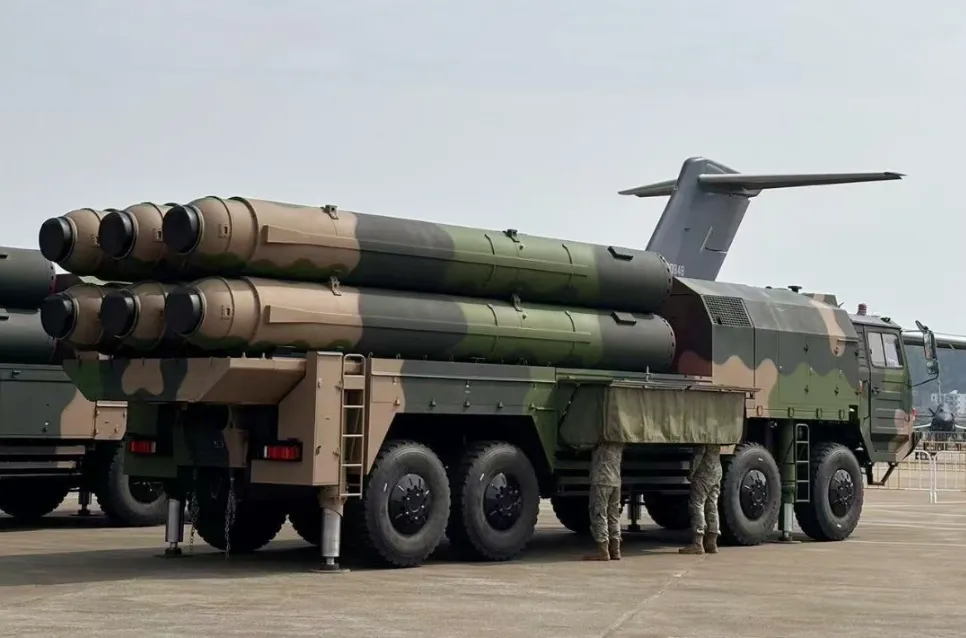Follow Us:

Share
Defense Feeds – China’s HQ-19 surface-to-air missile system, known as the Hongqi-19, is set to make its first public appearance at the 2024 Zhuhai Airshow, according to a report by defense analyst David Wang on November 5, 2024.

This advanced anti-ballistic missile (ABM) system, developed to intercept threats both inside and beyond Earth’s atmosphere, is comparable to the U.S. THAAD-ER system. While this marks its debut public showcase, the HQ-19 is already in active service with the People’s Liberation Army Air Force (PLAAF) and has been operationally tested.
The HQ-19 is mounted on an 8×8 high-mobility truck and features a six-missile launcher configuration. Utilizing a cold-launch technique at a steep angle, it efficiently intercepts incoming missiles. Its radar, including the 610A information radar, offers extensive detection capabilities—up to approximately 4,000 kilometers—covering regions from northern South Asia to China’s inland areas like the Tibetan Plateau. This radar data integrates seamlessly with the HQ-19’s command-and-control system, boosting tracking accuracy and interception precision.

The HQ-19’s roots trace back to China’s 863 Program in the late 1990s, an initiative focused on advancing high-tech defense. Its guidance system, featuring an infrared seeker with side windows, minimizes atmospheric interference for accurate high-altitude targeting.
The missile operates with a two-stage solid rocket engine, constructed with carbon-fiber materials and powered by the N-15B solid propellant, achieving a specific impulse of 260 seconds. This engine design includes a double-pulse feature, enhancing terminal kinetic effectiveness and extending the missile’s operational range. The missile’s structure allows maneuverability under forces up to 60g, essential for intercepting rapidly moving warheads.
With an intercept range of up to 3,000 kilometers, the HQ-19 can engage ballistic missiles, including those in reentry phases. Its kinetic kill warhead positions it among a select few global systems capable of physically neutralizing threats without explosives, relying instead on high-speed impact.
China’s success in kinetic kill technology dates to a 1999 test, making it the second country after the U.S. to achieve this capability. Since then, the HQ-19 has undergone numerous successful tests, including an interception at over 200 kilometers in altitude and relative speeds reaching 10,000 meters per second. A 2021 trial reported by China’s Ministry of National Defense confirmed the system’s effectiveness and reliability.
HQ-19 AD Launcher Vehicle
— David Wang (@Nickatgreat1220) November 5, 2024
The PLA Equivalent of THAAD ER | National Airshow at Zhuhai 2024
If PLA Ever Decides to Public Something Loooong Hidden, They definately Get a Better One
Trust me Bro pic.twitter.com/wNqSnYLMx6
The HQ-19’s appearance at the airshow may signal China’s readiness to export this system, with potential buyers in the Middle East. Historically, China’s defense exports have focused on key partners like Pakistan, Saudi Arabia, and Egypt, but the HQ-19’s sophisticated capabilities make it an appealing option for nations looking to strengthen their own missile defenses. This strategy aligns with China’s broader push to expand its defense sector globally, facilitating closer bilateral ties through military cooperation.
The HQ-19 operates within a layered missile defense framework, supported by complementary systems like the HQ-9 and HQ-26. The HQ-26, featuring a multi-pulse solid motor, is capable of intercepting various missile threats at extended ranges, while the HQ-19’s phased array radar provides early warning and tracking for a multi-tiered defense. Together, these systems create a robust shield, capable of countering regional ballistic missile threats from neighboring countries.
The HQ-19 represents China’s commitment to advancing missile defense in response to shifting regional power structures. Analysts suggest it may serve as a deterrent against ballistic missile systems in South Asia, including India’s Agni-4 and Agni-5 missiles.
By unveiling the HQ-19, China underscores its emphasis on strengthening missile defense amid evolving global security challenges. The system’s demonstrated effectiveness and integration within China’s defense network illustrate its pivotal role in both national security and potential regional stability.
The HQ-19’s capabilities, comparable to the U.S. THAAD and SM-3 systems, will likely impact regional defense dynamics, further positioning China as a key player in modern missile defense technology.
Share
Defense Feeds is publication focusing on informing, engaging, and empowering the world by providing accurate information from defense technology.
Powered by Defense Feeds © 2025 – All rights reserved.